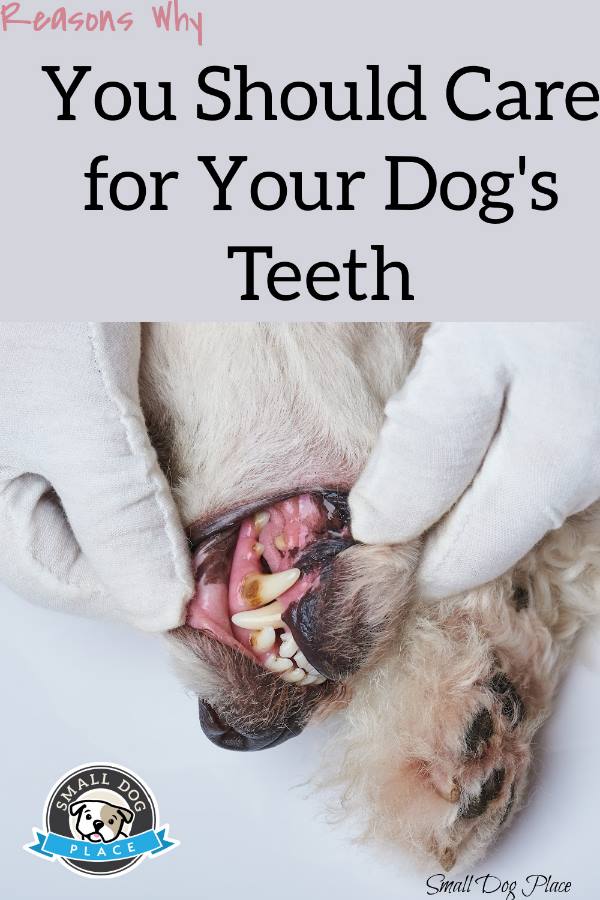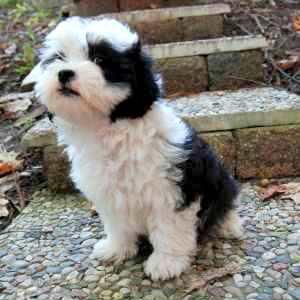- Small Dog Place Home
- Health
- Caring for Adult Dog Teeth
Adult Dog Teeth: Caring for Your Dog's Dental Health Needs at Home
by Janice Jones |Last Updated: 11-8-2022
Adult Dog Teeth, just like people teeth, need good dental hygiene not only to protect the teeth, but for your dog’s overall health.
Poor dental hygiene can affect your dog’s teeth and mouth, but it can also extend to your dog’s vital organs. The American Veterinary Dental Society reports that 80 percent of dogs show signs of oral disease by age three.
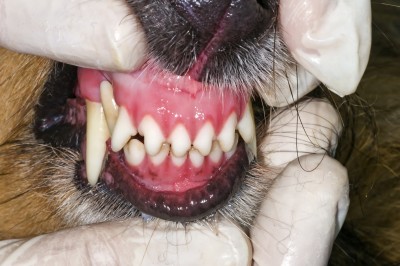
How Many Teeth Does a Dog Have?
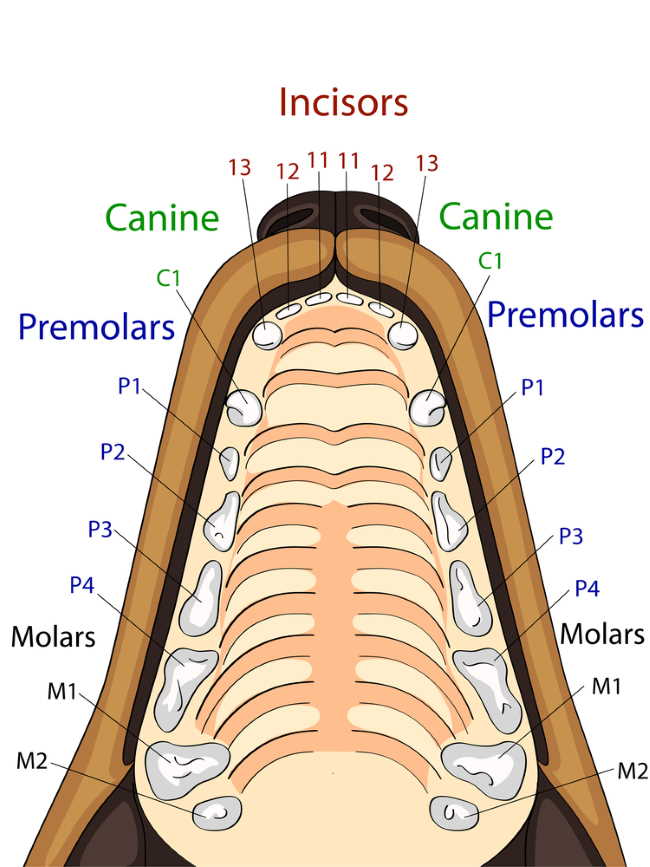 Adult Dog Teeth
Adult Dog TeethDogs get two sets of teeth, just like us. Their first set consists of 28 deciduous teeth, also known as baby teeth or milk teeth.
They begin to show at about 2 weeks of age and in most breeds have erupted by 10 weeks of age. Anyone who has ever had a puppy know how sharp these little teeth are and why bite inhibition is on the top of most owners' training to-do list.
They loose them as fast as they grown in and by the time a puppy turns six months old, the full 42 adult teeth have replaced the first set.
Puppy Breath? Some people love the smell of puppy breath. That odor is present as long as the puppy is teething (baby teeth erupting and then falling out; adult or permanent teeth growing in) Once the adult dog teeth are in, the puppy breath goes away.
Some animals such as sharks can regrow the permanent teeth. Like us, dogs cannot.
Do you have a puppy who is less than one year old? Please check out our page on Puppy Dental Care for more information specific to puppy dental care.
Dogs have four different types of teeth: Incisors, canines, premolars and molars. Each type of tooth is used for a specific purpose.
Incisors
Adult dogs have a total of 12 incisors, six on the top and six on the bottom. They use these to scrape meat from bones, pick at parasites or foreign objects stuck to their hair, and for grooming.
Canines
Dogs have four canine teeth, two on the top and two on the bottom. Also referred to as fangs, they are used to tear apart or hold onto something or puncture an object. They are also used to lock onto something in their mouth such as a bone. If you have ever tried to pull something away from your dog's mouth, you know how strong a dog's grip can be.
Premolars
These are the flatter but still very sharp teeth directly behind the canines and are used to chewing and shearing. There are a total of 16 premolars, 8 on the top and 8 on the bottom or four on each side of the mouth. The largest teeth in a dog's mouth is the top 4th premolar also known as the carnasial.
You've no doubt seen your dog chewing on a bone on the side of his mouth. He is using his premolars. Dogs use these teeth to chew most any type of food.
Molars
Molars are the large, flat teeth found at the back of the mouth and are used to chew and grind. Dogs have four molars on the top and six on the bottom. Without the molars, chewing hard kibble and biscuits is much more difficult.
Why Worry About Adult Dog Teeth?
Good dental hygiene is just as important for dogs as it is for humans. If done properly at home, you will reduce the number of professional cleanings your dog will need over the course of his lifetime.
Don't wait until the adult dog teeth have come in completely before beginning a dental routine at home. Puppy teeth can be hard to brush, but they sure enjoy chewing on the toothbrush.
Dental Disease
Dental disease, or periodontal disease is the inflammation of the tissues surrounding the tooth or periodontal tissue.
Gingivitis occurs when plaque and tarter build up, causing bone erosion and eventual loose teeth. Periodontal disease affects more than two-thirds of dogs over the age of three.
The following are signs that your dog may have a problem in his mouth or gastrointestinal system. If you notice any of these, consult your veterinarian.
Signs of Oral Disease in Adult Dog Teeth
- Bad breath
- Excessive drooling
- Inflamed gums
- Tumors in the gums
- Cysts under the tongue
- Loose teeth
Dental disease affects the whole body, too. Bacteria from these inflamed oral areas can enter the bloodstream and affect major body organs.
The liver, kidneys, heart, and lungs are most commonly affected. Antibiotics are used prior to and after a dental cleaning to prevent bacterial spread through the bloodstream.
What is the Difference Between Plaque and Tartar?
There is a difference between plaque and tartar. Plaque is bacteria mixed with saliva and blood cells that leads to tooth and gum disease.
Tarter, on the other hand, tarter occurs when plaque hardens and firmly sticks to the tooth, eventually wearing down the tissue around the tooth. So what can you do to keep your dog's mouth healthy and clean?
What Do You Need to Care for Those Pearly Whites?
Your Shopping List is small. You will need:
- Canine Toothpaste
- Canine Toothbrush
- If your dog will not accept a toothbrush, consider a rubber finger brush, dental wipes, or gauze.
Tasty Canine Toothpaste
Do not use human toothpaste as it is likely to make your dog sick. Avoid human toothpaste because it has Xylitol, a sweetening agent that is toxic to dogs. Human pastes also have a foaming agent that is not necessary for our dogs.
A dog will swallow a lot of toothpaste while you brush so it is important to use toothpaste designed for dogs. The canine toothpaste is usually acceptable to dogs because it comes in flavors that dogs prefer such as beef, chicken, liver and even mint.
Most dogs find the meat flavors yummy which makes brushing a breeze. If you prefer, you can use baking soda, but dogs may not take to it as easily as commercially prepared canine toothpaste.
Perfect Sized Toothbrushes
A dog toothbrush is smaller than and has softer bristles than a human toothbrush. Many toothbrushes are dual ended, including a regular size and a smaller, tapered end. Often the tapered end is perfect for small dogs with small mouths.
Alternatives to Toothbrushes When Caring For Your Adult Dog's Teeth
Again, if your dog does not like the toothbrush, you can still take care of his dental hygiene needs.
Some dogs tolerate soft rubber finger brushes that you place over your index finger. It has soft knobs that break apart tarter as you rub your finger around the dog’s mouth, over the teeth and on the gums.
If your dog is super-sensitive to anything in his mouth beside food, dental wipes might be the answer. Most come in two inch circles and will stay fresh in the plastic container. They are flavored so most dogs find them tolerable, even yummy! But, they are not edible, so don't let your dog swallow them.
Another option is to use an additive to your dog's water that helps keep teeth clean. This one uses all natural ingredients with green tea as the main one.
A capful in your dogs water will save you from having to brush your dog's teeth. This is great for the dog that hates to have his teeth brushed.
I spent some time investigating some water additives for my own small breed dogs. You can read my review here at Such Good. Additives are an excellent alternative if you have a dog that hates to have his teeth brushed.
How to Brush Adult Dog Teeth
Pick a time when your dog is relaxed, calm and sleepy. The best time I have found for brushing teeth is after a romp or walk. My dog has eaten and gotten a big drink of water.
- If you have never brushed her teeth before, acclimate her to the toothbrush and toothpaste. Place a dab of toothpaste on your finger and let her lick it off. Next, while holding her muzzle in one hand, gently touch to toothpaste to her teeth without brushing. Talk quietly and reassuringly as you touch the toothbrush to different teeth.
- Place a dab of toothpaste on the toothbrush. Angle the brush about 45 degrees from her front teeth and canine tooth. Brush gently in a circular motion. The first time you brush, limit it to the front teeth only.
- Gradually over several days build up to brushing more teeth, moving slowly to the back teeth. If any tarter flakes off, remove it before the dog can swallow.
- A little bleeding is acceptable, but if the teeth bleed profusely, you are either brushing too hard or she is developing gingivitis or other oral diseases. Stop and make an appointment with your veterinarian.
Scrapping/Scaling Adult Dog Teeth at Home
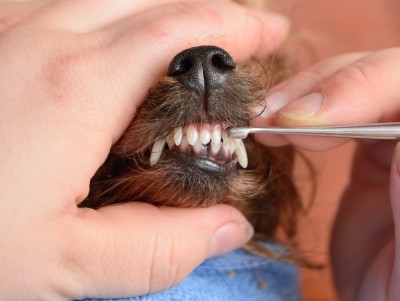 Scrapping tarter from dogs' teeth
Scrapping tarter from dogs' teethSome owners opt to scrap or scale their dog’s teeth themselves. If the dog is cooperative, this is a sure way to prevent disease and keep their pearly whites in great shape. You can use a human plaque scraper that is available in any store with a dental health section or you can purchase one designed for dogs.
If you decide to do this yourself, have gauze or paper towels handy. As you scrape the tooth, catch any loose flakes of tarter from the scraper and the dog’s mouth. Do not allow your dog to swallow any loose tarter.
WARNING: If the dog resists, don't press the issue. Scrapes can be very sharp and cut into the gums if the dog moves away quickly. This is best left to the professionals who will make sure your dog is anesthetized before beginning any procedures.
Professional Care for Adult Dog Teeth
If you notice any of these problems in your dog's adult dog teeth, it is very important to call and schedule a consultation with your veterinarian. If your dog has tarter on his teeth and showing signs of disease, he may need a professional cleaning in the veterinarian’s office.
Cleaning at a clinic is similar to that which we receive when we visit a dental hygienist to have our teeth cleaned with one major exception. Dogs cannot talk and tell the veterinarian where it hurts, and they cannot sit in a chair willingly with their mouth open, canine patients must be anesthetized for the veterinarian to get a good look and do a proper job.
Dental X-rays may be done and scaling and polishing are done while the dog is monitored under anesthesia.
Daily brushing is the best thing that you can do to increase your dog’s dental health. In addition, you can still offer other things to your dog to assist you in the process.
Doggie Breath Got You Gagging?
To help control your dog’s bad breath, you can also offer them chew toys that massage their teeth and gums, removing sticky tartar and plaque.
Many dental toys are made of natural rope fibers that act as floss, while other enticing dental toys offer a variety of interesting textures, with ridges and grooves for the dogs to work on while his teeth are maintaining their natural white glow.
Chew bones especially designed edible dental chews also reduces tarter and helps freshen breath. They generally come with no preservatives and are gluten-free to help with digestion. Finally, you can check with your veterinarian for food recommendations that assist with tarter control.
Here are a couple of suggestions for dog chews that I have used. Some chews can cause GI symptoms, so I recommend that you purchase a small quantity first to be sure your dog will tolerate them well.
Dog Dental Sticks for Adult Dog Teeth
Many people rely on dental chew bones for their dog's dental health. The products below are some I've tried and that my dogs like. If you happen to be in the UK, you might want to check out these dog dental sticks.
Adult Dog Teeth Takeaway
While dental care is not likely to be on your bucket list of fun activities with dogs, your diligence will pay off and potentially lengthen the lifespan of your dog, prevent unnecessary visits to the veterinarian, keep your dog's adult dog teeth clean and mouth smelling fresh, and help your dog live a long happy life.
Pin for Future Reference
Did You Find This Article About Adult Dog Teeth Helpful?
What Do You Think?
Have any comments, concerns, ideas or suggestions about what you just read?
Do you have any comments about this page that you'd like to share? Please take a moment and share your thoughts, ideas, comments, or suggestions for everyone to read.
About Janice (author and voice behind this site)
Janice Jones has lived with dogs and cats for most of her life and worked as a veterinary technician for over a decade. She has also been a small-breed dog breeder and rescue advocate and holds academic training in psychology, biology, nursing, and mental health counseling. Her work focuses on helping dog owners make informed, responsible decisions rooted in experience, education, and compassion.
When not writing, reading, or researching dog-related topics, she likes to spend time with her six Shih Tzu dogs, her husband, and her family, as well as knitting and crocheting. She is also the voice behind Miracle Shih Tzu and Smart-Knit-Crocheting
Does This Article Deserve Your Thumbs Up?
We always appreciate your support and encouragement. Your thumbs up means so much to us. Please like this article.
If you find this page or any page on Small Dog Place Helpful, or useful in anyway, I'd love it if you would click the small heart found on the bottom right of each page.
You can also share or bookmark this page -- just click on the:

Free Monthly Newsletter
Sign Up for Our Free Newsletter and get our Free Gift to You.
my E-book, The Top 10 Mistakes People Make When Choosing a Dog (and how to avoid them)



